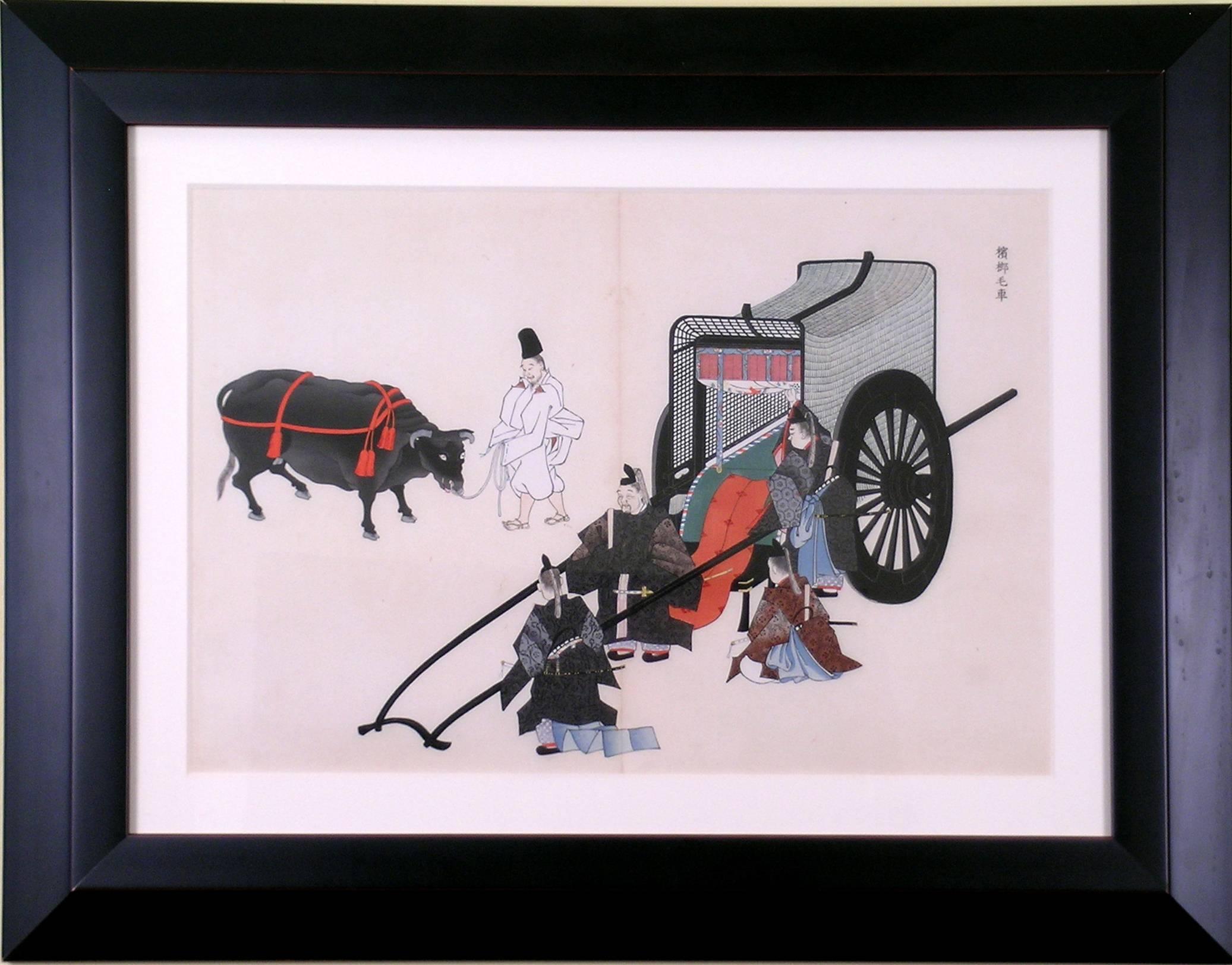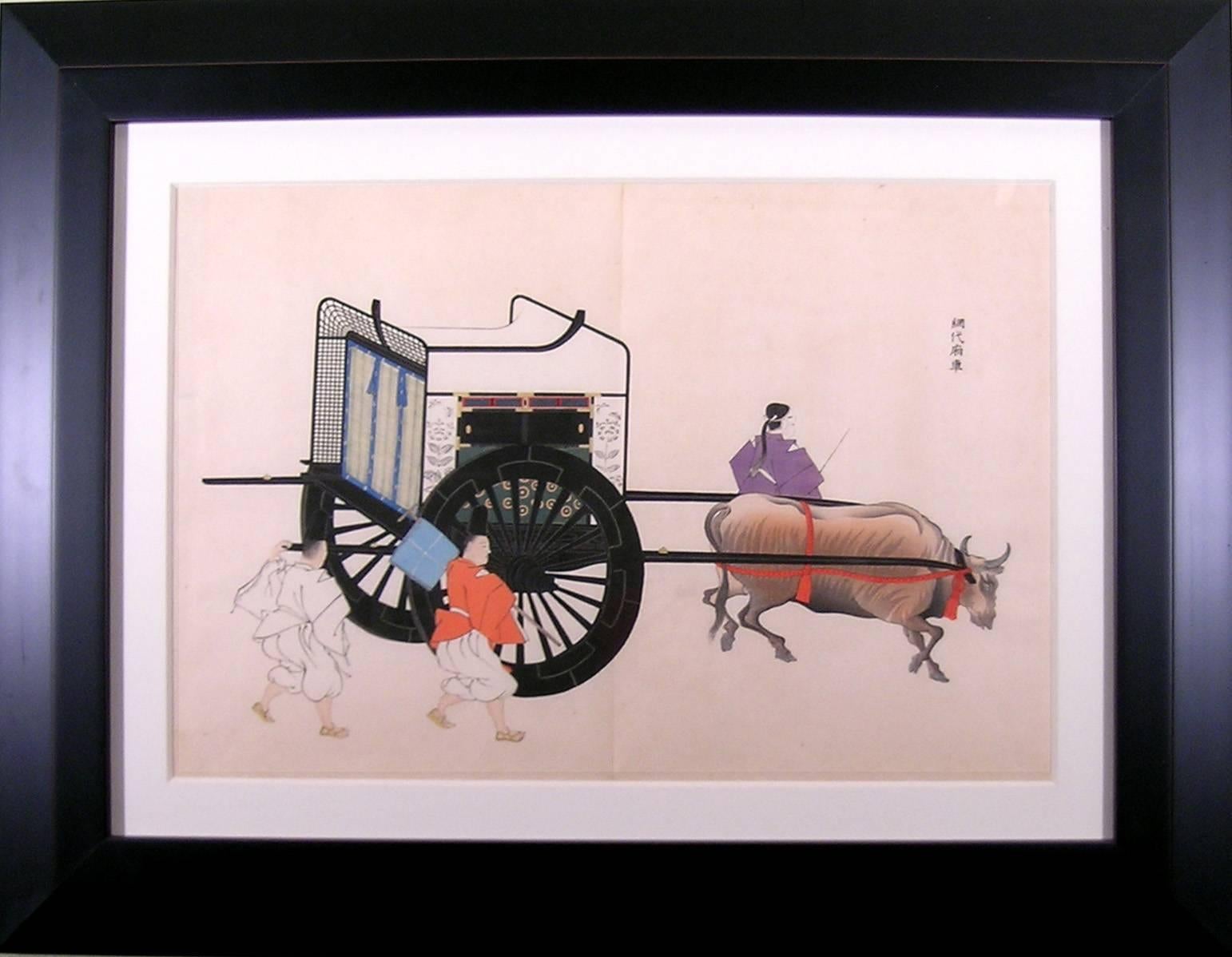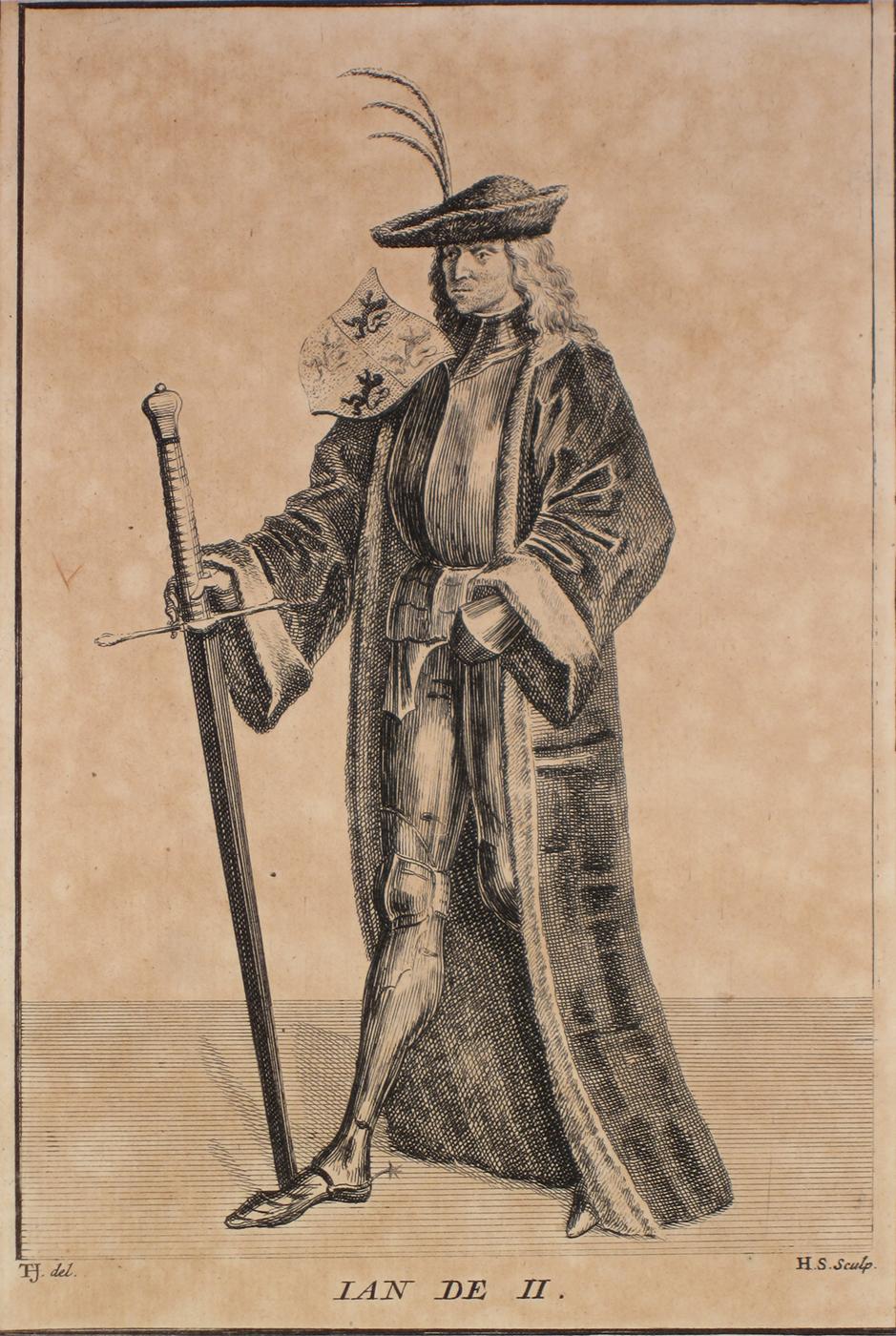Want more images or videos?
Request additional images or videos from the seller
1 of 9
Yosha Zuko FuzuTransport with 5 People and 2 Parasols1900
1900
About the Item
Yosha Zuko Fuzu
Meiji 33 (1900)
Woodcut with Original Hand-Coloring
Writer: Kosugi Onson, Imaizumi Teisuke
Publisher: Yoshikawa Hanshichi
The Japanese litters and palanquins are much more than a practical vehicles for transport. They can also be a symbol of wealth and power. Every detail has a special significance. The quality, quantity, color and design of the hand-made embroidered silk fabrics add to the status of the passenger. The number of oxen needed and the hand-painted design of the palanquin and length of the yokes determine social class. Of course, there are man-powered litters as well. In each illustration we see the robe, sashes and hats worn by the carriers all adding to the worth of the patron. Of special significance is the color saffron denoting great extravagance. Each example holds a fascination in the meticulous attention to the smallest addition of a piece of trim and in the way a single knot is tied.
This work illustrates finely made and ornamented covered litters and palanquins to be carried by as many 15 men or several oxen. Every detail and movement is directed by additional staff. Only a very important individual could afford such extravagance.
Woodblock printing flowered in the Edo Period, mid to late 19th century, and is still considered an art form of great precision and beauty. The illustrations of these carts capture both the vitality and life inherent in the images of man, beast and carriage in each color woodblock print. Following the artist sketch, an image is carved into a block of wood. Black inks form the outline of the subject and color inks are applied to specific areas. The woodblock is then pressed to hand-made screened paper which is then hung dry. The entire process of composing a single image can take weeks.
- Creator:Yosha Zuko Fuzu (Japanese)
- Creation Year:1900
- Dimensions:Height: 21 in (53.34 cm)Width: 27 in (68.58 cm)
- Medium:
- Movement & Style:
- Period:
- Condition:Clean, crisp image. Beautiful original color. Framed to museum specifications using archival matting, backing, hinging. Glazed with ultra-violet filtering Plexiglas.
- Gallery Location:Florham Park, NJ
- Reference Number:
About the Seller
5.0
Gold Seller
These expertly vetted sellers are highly rated and consistently exceed customer expectations.
1stDibs seller since 2014
161 sales on 1stDibs
Typical response time: 3 hours
- ShippingRetrieving quote...Ships From: Florham Park, NJ
- Return PolicyA return for this item may be initiated within 1 day of delivery.
More From This SellerView All
- Oxcart with 5 Men and 1 OxBy Yosha Zuko FuzuLocated in Florham Park, NJYosha Zuko Fuzu Meiji 33 (1900) Woodblock with Original Hand-Coloring Writer: Kosugi Onson, Imaizumi Teisuke Publisher: Yoshikawa Hanshichi The Japanese litters and palanquins...Category
Early 1900s Academic Figurative Prints
MaterialsWatercolor, Woodcut
- The PlanLocated in Florham Park, NJSamurai Warriors Meiji 33 ( 1900) Woodblocks Original Hand-Color Woodblock printing flowered in the Edo Period in Japan, mid to late 19th century, and is still considered an ...Category
Early 1900s Academic Figurative Prints
MaterialsWatercolor, Woodcut
- Oxcart with 3 MenBy Yosha Zuko FuzuLocated in Florham Park, NJYosha Zuko Fuzu Meiji 33 (1900) Woodblock with Original Hand-Coloring Writer: Kosugi Onson, Imaizumi Teisuke Publisher: Yoshikawa Hanshichi The Japanese litters and palanquins...Category
Early 1900s Academic Figurative Prints
MaterialsWatercolor, Woodcut
- Templum Iovis Romae (Temple of Jove)Located in Florham Park, NJBeautifully hand-colored lithograph illustrating Roman architecture.Category
1750s Figurative Prints
MaterialsWatercolor, Lithograph
- OrchidBy Kono BaireiLocated in Florham Park, NJKono Bairei (1844 – 1895) One Hundred Flowering Plants. Japan, 1901. (Posthumous.) Woodblock Print. 15 x 11.unframed. Okura Magobei, Publisher. The enthusiasm for nature prints transcends the centuries. “One Hundred Flowering Plants” is a mid-nineteenth century work illustrating varieties of flowers and plants in naturalistic styles. Traditional woodblock printing enhances the beauty of each work. The artist must carve different woodblocks for every color he wishes to transfer to paper. In this style of printing it is imperative that the register of each woodblock be exact as they must match perfectly to create an image without blurring. In addition to his illustrated flower books...Category
Early 1900s Academic Prints and Multiples
MaterialsWoodcut
- Kimono: Woman in OrangeBy Matsui YuokuLocated in Florham Park, NJREISHIN GACHO (Album of Beautiful Designs) Japanese Kimono Designs Matsui Yuoku, Painter Japan, 1900 (Meiji 33) Honda Ichijirou, Publisher Woodblock Prints Celebrated as mu...Category
Early 1900s Academic Prints and Multiples
MaterialsWoodcut
You May Also Like
- The United StatesLocated in Sydney, NSW19th Century chromolithograph, The United States (Vanity Fair), under the pseudonym of ApeCategory
19th Century Academic Figurative Prints
MaterialsLithograph
- John II, Count of Hainaut Holland & Zeeland (1247-1304)Located in Sydney, NSW18th Century (c1740) etching/engraving , John II, Count of Hainaut Holland & Zeeland (1247-1304)Category
19th Century Academic Figurative Prints
MaterialsEngraving, Etching
- InnamoratiBy Emilio GrecoLocated in Ljubljana, SIInnamorati (eng. Lovers). Original drypoint, 1982. Edition of 90 signed and numbered impressions on Arches paper. Emilio Greco is one of the greatest sculptors, engraver and medalist of modern time. He is best known for his monumental bronze sculptures of the human figure. The sculptures and figures in graphics, primarily female nudes and portraits, tended to be refined, with elongated forms in the Italian...Category
1980s Academic Figurative Prints
MaterialsDrypoint
- Plums: George Brookshaw's Framed Hand-colored 19th C. AquatintBy George BrookshawLocated in Alamo, CAGeorge Brookshaw's (1751-1823) beautiful "Plums" hand colored aquatint engraving from his "Pomona Brittanica", considered to be the finest British botanical large format treatise of the 19th-century. His engravings were unique for their rich tones and colors, elegant compositions with the fruit seeming to float on a mottled sumptuous background. There are purple, mustard-colored plums on brown branches with green leaves over a two-tone dark brown and light tan background. The print is presented in an ornate bronze-colored wood frame with gold-colored inner and outer trims and a triple mat. The outer mat is a marbled light...Category
Early 19th Century Academic Figurative Prints
MaterialsAquatint
- Peaches, Nectarines: George Brookshaw's 19th C. Framed Hand-colored AquatintBy George BrookshawLocated in Alamo, CAGeorge Brookshaw's (1751-1823) beautiful "Peaches, Nectarines" hand colored aquatint engraving, plate 38 from his "Pomona Brittanica", considered to be the finest British botanical large format treatise of the 19th-century. His engravings were unique for their rich tones and colors, elegant compositions with the fruit seeming to float on a mottled sumptuous background. The pale green and peach-colored peaches and the pink and green flowers lie on a rich dark brown-colored background. The print is presented in an ornate bronze-colored wood frame with gold-colored inner and outer trims and a triple mat. The outer mat is a marbled light...Category
Early 19th Century Academic Figurative Prints
MaterialsAquatint
- Buttercup Flowers: A Besler 18th Century Hand-colored Botanical EngravingLocated in Alamo, CAThis is a hand-colored copper plate engraving depicting Ranunculus (Persian Buttercup) flowers from Basilius Besler's landmark work, Hortus Eystettensis (Garden at Eichstatt), first ...Category
Early 18th Century Academic Still-life Prints
MaterialsEngraving
Recently Viewed
View AllMore Ways To Browse
Antique People
Mid Century Fabric Print
Japanese Wood Block Prints
Wood Block Prints Japan
Antique Japanese Fabrics
Mens Silk Print
Antique Wood Print Blocks
19th Japan Silk Paint
Antique Yokes
Antique Yoke
Yoke Antique
Hand Blocked Print Fabric
Meiji Woodblock
Antique Vehicle
Black Silk Robe
Parasols Antique
Antique Parasol
Parasol Antique




